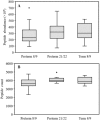Milk Peptides Survive In Vivo Gastrointestinal Digestion and Are Excreted in the Stool of Infants
- PMID: 31883006
- PMCID: PMC7138664
- DOI: 10.1093/jn/nxz326
Milk Peptides Survive In Vivo Gastrointestinal Digestion and Are Excreted in the Stool of Infants
Abstract
Background: Human milk peptides released by gastrointestinal proteases have been identified with bioactivities that can benefit the infant but must first reach their respective sites of activity. Peptides in the stool either survived to or were released inside the intestinal tract, and thus had the opportunity to exert bioactivity there. However, it is unknown whether any milk peptides, bioactive or not, can survive in the stool of infants.
Objective: The aim of this study was primarily to identify milk peptides in infant stool samples and secondarily test the hypotheses that the milk peptide profiles of stools are different between preterm infants at different days of life and between preterm and term infants.
Methods: Infant stool samples were collected from 16 preterm infants (<34 weeks gestational age) at 8 or 9 and 21 or 22 days of life (DOL), and from 10 term infants (>34 weeks gestational age) at 8 or 9 DOL. Milk peptides were isolated from the stool samples and identified using tandem MS. The peptide counts and abundances were compared between infant groups.
Results: In total, 118 exclusively milk-derived peptides from the caseins and α-lactalbumin were present in the stool samples, including some peptides with known or potential bioactivity. The remaining 8014 identified peptides could be derived either from milk or endogenous proteins. Although many individual milk peptides were significantly different between preterm infants at 8/9 and 21/22 DOL and between preterm and term infants, total peptide abundance and count were similar for all 3 groups.
Conclusions: This is the first study to confirm the survival of milk peptides in the stool of infants. Some of the peptides had potential bioactivities that could influence infant gut development. These results are important to understand the physiological relevance of human milk peptides to the infant.
Keywords: bioactive; human milk; infant; peptides; stool.
Copyright © The Author(s) 2019.
Figures





References
-
- Liepke C, Adermann K, Raida M, Mägert HJ, Forssmann WG, Zucht HD. Human milk provides peptides highly stimulating the growth of bifidobacteria. Eur J Biochem. 2002;269(2):712–8. - PubMed
-
- Parker F, Migliore-Samour D, Floch F, Zerial A, Werner GH, Jollès J, Casaretto M, Zahn H, Jollès P. Immunostimulating hexapeptide from human casein: amino acid sequence, synthesis and biological properties. Eur J Biochem. 1984;145(3):677–82. - PubMed

